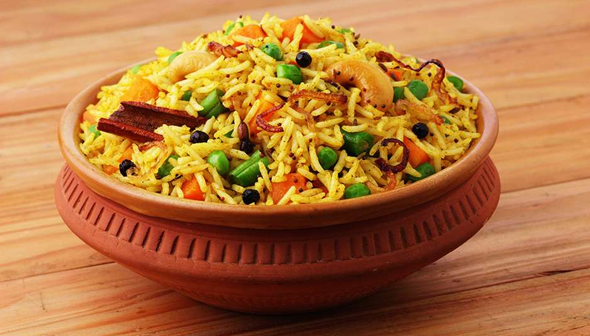Mama’s Punjabi Recipes: Subzi Pulao (Vegetable Pilaf)
Saved under Community, Current Stories, Recipe Corner
Tags: Baytown, Clear Lake, Cypress, Desi news, Greater Houston, Houston, Houston Desi news, India, Indian American community, Indian News, Indians in America, Indo-American News, Katy, Mama’s Punjabi Recipes, NRI, pearland, Shakuntla Malhotra, south asia, South India, Subzi Pulao, Sugar Land, Texas, USA
For many people – especially the young who are just starting out in life – who tire of making simple dishes and want to add a little extra flavor, this recipe is a variation on making plain rice and can be made with not that much more effort. The results can be very encouraging as this Subzi Pulao can be a meal in itself, which is presented here again with more details!
Chawal (rice) is a staple grain that has spread all across the globe, just as wheat (gehun), makki (corn) and bajra (millet). All over the world, Indian Basmati chawal is very well regarded for its aromatic flavor and long, hardy grains that don’t become mushy when cooked. Chawal is a basic ingredient in many Indian cuisines, irrespective of which part of the country you come from. But for special occasions like weddings, rice is usually prepared as a pulao, which can include vegetables or various meats.
The sacred Hindu text Mahabharata mentions rice and other ingredients cooked together and the word pulao or pallao is used in ancient Sanskrit works. Pulao is a method of cooking adopted from the Persians who have been credited for the first known recipe in the tenth-century. Pulao is a dish in which rice is cooked in a seasoned broth. In some cases, the rice may become brown depending on the use of onions, a balance of spices and meat or vegetables, depending on the local cuisine.
Variations of pulao – also called pilaf in many countries – can be found in the Middle East, Central and South Asia, East Africa, Latin America and the Caribbean. It is one of the oldest dishes that has existed in parts of Central Asia. Biryani is another variation of a dish cooked with layers of rice and meat or vegetables and with more spices, and was introduced to India by the Mughals. Interestingly, the word pulao (PU-lao) means dragon in Mandarin and refers to the small dragon that appears as a decoration on Chinese bells.
Among Punjabis, pulao is usually cooked at special occasions, but it does not have to be complicated to make. I have seen, though, that many people do not know how to make this dish easily, without much effort, so I hope this recipe will help them. For best results, use the aromatic Basmati rice.
Ingredients:
• 2 cups chawal (rice).
• 1/2 cup mutter (peas)
• 1/2 cup phul gobi (cauliflower)
• 1/2 cup aloo (potatoes)
• 1/2 cup gajjar (carrots)
• 1 large pyaaz (onion)
• 2 tbsp olive oil or any other oil you prefer
• 1/2 tsp jeera (cumin) (can be omitted, if desired)
• 2 illachi (cardamom)
• 1 stick daal chini (cinnamon)
• 4 loong (cloves)
• 4.5 cups pani (water)
• Namak (salt) to taste
Directions:
1. Soak the rice for 10 minutes in cold water.
2. Peel the onion and cut into thin slices. Wash the vegetables and cut them into medium pieces.
3. Heat the oil in a medium sized pot and place the sliced onions and cumin in it, stirring till they are slightly brown. Add the vegetables, add ½ cup water and stir till slightly brown. If you use frozen vegetables, then there’s no need to add the water.
4. Add 4 cups of water and let the mixture come to a boil, stirring occasionally.
5. Drain the rice; crack open the cardamom, break the cinnamon into four pieces and throw these in the boiling water along with the cloves. Add salt to taste.
6. When the water has boiled again, turn the heat down to simmer, cover the pot and let it cook for 15 minutes over very low heat.
7. Check if the rice is soft (it should not be mushy) and with a pointy knife or fork, make sure that it isn’t sticking to the bottom but do not stir.
8. When done, turn the heat off, keep the cover on and let the pulao stand for 10 minutes. Serve warm with other dishes and yogurt or raita.
MAMA’S TIP OF THE WEEK: SOME TIPS TO ADD FLAVOR TO FOOD FOR THOSE ON A SALT FREE DIET
If you are on a salt-free diet as I am, then everyday you face the prospect of eating a meal that is not satisfying because it lacks the taste that you have long been accustomed to. I have long struggled to add some variety for my taste buds and after many trials and errors have developed some alternatives to make my meals tasty.
The chief strategy is to replace “salt” with “bitter” which adds tanginess to food. There are several ingredients that do that, like slightly bitter yogurt, green mango powder, paprika (though a little spicy), onion powder, rye, mustard, garlic and white vinegar (used sparingly). There are other foods which are naturally bitter like methi (fenugreek) and karela (bitter gourd) which can also be used in powder form to sprinkle on dishes. And finally, tomatoes can often add bitterness when added to a dish.

Shakuntla Malhotra is a skilled cook of Punjabi dishes made in the old-fashioned style that she learnt as a young woman in her ancestral home in Lyallpur, India (since renamed Faisalabad) before it became part of Pakistan after the Partition in 1947. People have often admired her cooking for its simplicity and taste that comes with each mouthful. Even in her late-eighties, she continues to cook daily and agreed to share her delectable Punjabi vegetarian recipes for future generations.

